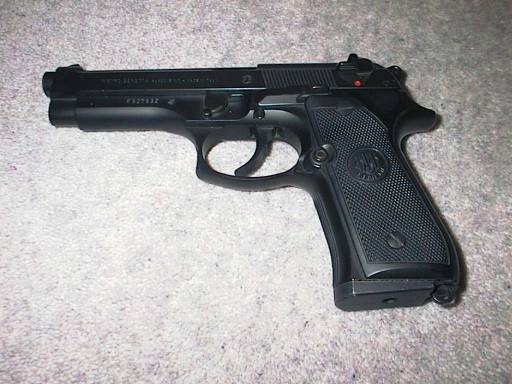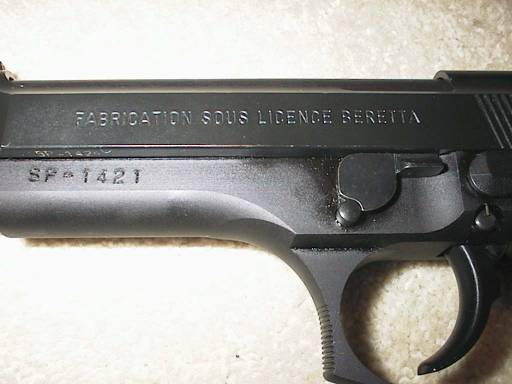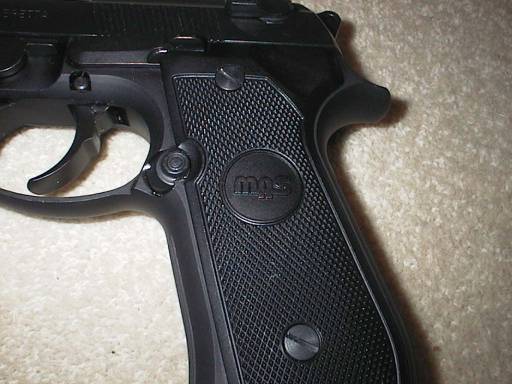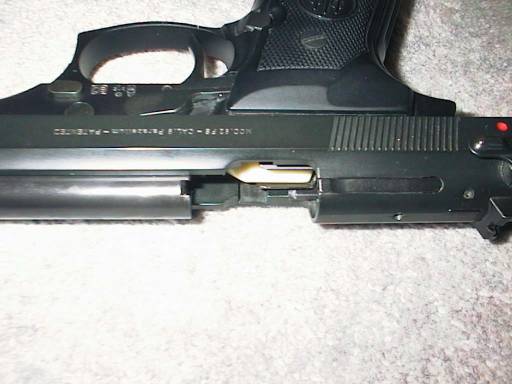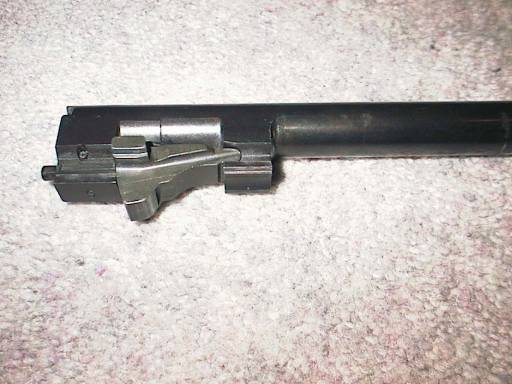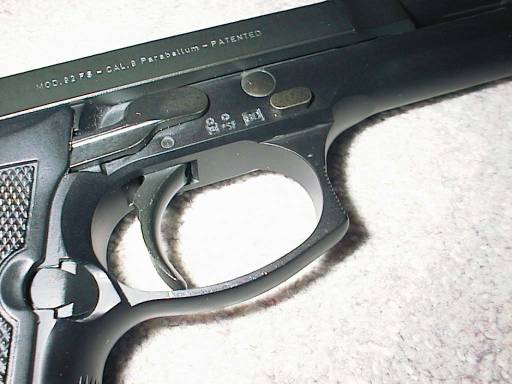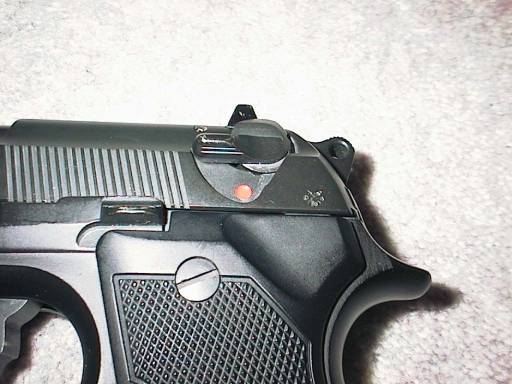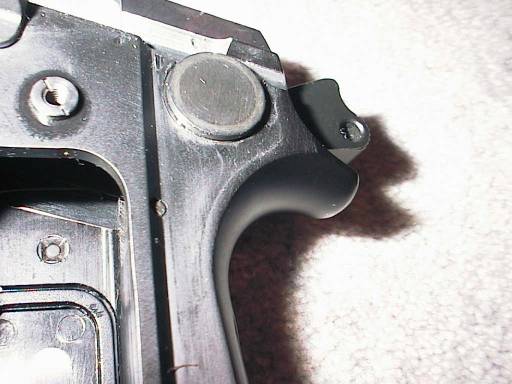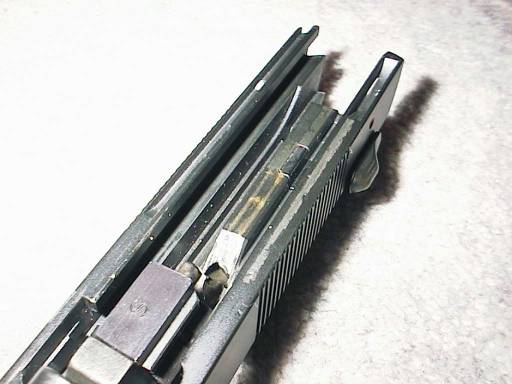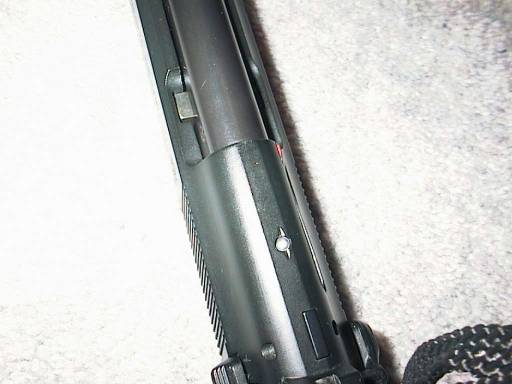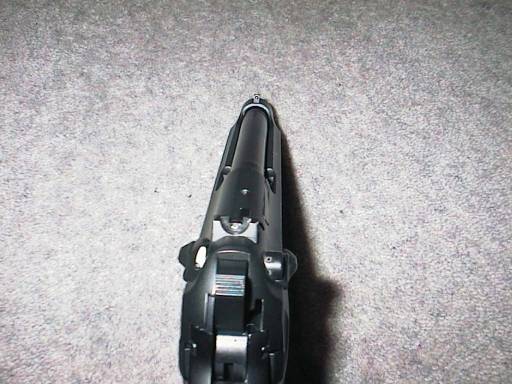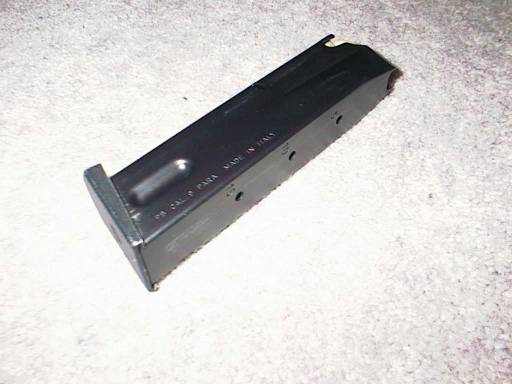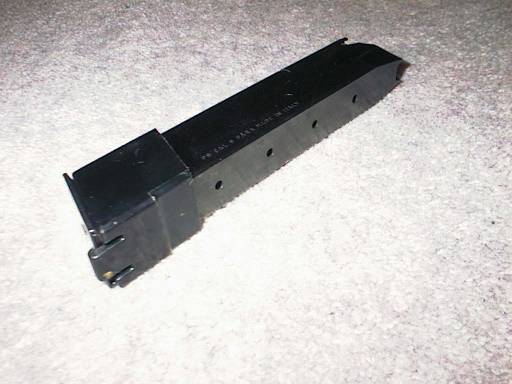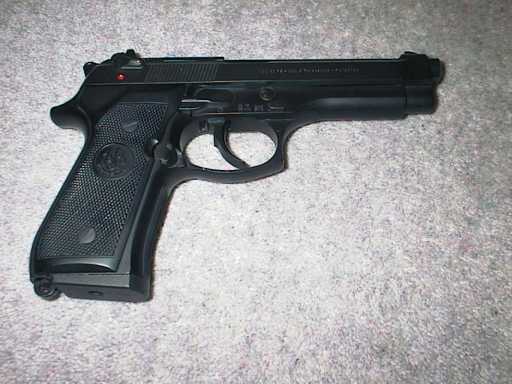[This review originally appeared on the Deactivated Guns Collector’s Association website in April 2001 – Ed.]
The Beretta 92FS, its predecessors and its copies are quite possibly the most common pistols in the world today, only the Browning Hi-Power can claim anywhere near the acceptance.
As it is one of the world’s most common pistols, it has obvious interest to collectors due to the wide variety of manufacturers and variants of the basic model that have been made over the years.
Beretta is the oldest gun company in the world, with a history that can be traced back to 1526. Today it is a leading maker of small arms, and highly respected as such for the simple reason that everything it makes goes “bang” when it’s supposed to! The Beretta 92FS is one of the company’s leading products.
Currently, the 92FS or slightly different versions or copies of it are in service with the armed forces of Brazil, Chile, Egypt, France, Italy, Mexico, South Africa, Spain and the United States. It is also extremely common among police, being used by the French Gendarmerie, Italian police, and a huge number of US police agencies, including the Los Angeles Police Dept. (popularised by the film “Lethal Weapon”) and the Immigration and Naturalization Service. Indeed, my local police here in the UK use it.
France makes a licensed copy of the 92, called the PA MAS G1 (Pistolet Automatique d’ MAS), that is manufactured by MAS in St. Etienne. France has so far manufactured 103,000 of these guns for the Gendarmarie, French Air Force and some elite units. Here you can see the markings:
and on the grip panels:
The Spanish company Llama makes an unlicensed copy called the Llama M82, and the South African company Vektor makes a licensed copy called the Z88. Taurus make a copy in Brazil called the Taurus PT-92 (or PT-99 with adjustable sights). FAMAE of Chile makes (or made) a version similar to the Taurus for the Chilean military. In addition, Beretta themselves make the pistol both in Italy and in Accokeek, Maryland, for supply to the US Armed Forces and also for civilian and police sales.
Despite its relatively short life, the history of the Beretta 92 series is too long to completely recount here. There are however several books on the subject, and if you’re really interested I suggest you track them down. The reason for the extended history is largely because of the controversy caused by the US adoption of the pistol. I will attempt however to give you the short version:
One of the interesting features of most Beretta pistols is the open top slide, that you can see in the following picture:
This was a feature Beretta had used on almost all previous designs, including most prominently the Beretta 1934, a 9mm Short calibre blowback pistol widely used during World War Two, which later evolved into the 9mm Beretta 951 “Brigadier”. The Brigadier was also a popular pistol, and to retain the distinctive open-top slide, Beretta copied the locking mechanism off the Walther P38 in order to accommodate the more powerful 9mm pistol cartridge:
Essentially, as the barrel recoils after firing, it moves backward in a slot in the frame, until reaching a cutout into which the ears at the back of the lug drop down into the cutout, arresting the movement of the barrel. This provides the delayed blowback mechanism necessary for the 9mm cartridge. Beretta carried this feature over to the model 92.
Beretta launched the model 92 in 1975, amid the introduction of a number of other designs, notably the SIG-Sauer P220 and the Brno CZ-75, both classic designs themselves. Initially it was sold to the Brazilians, who later built their own factory to manufacture it. After the military contracts were finished, Beretta sold the plant to Forjas Taurus, who continue to make their own version of the 92 to this day. Indeed, many people consider their version to be better (usually because of the frame-mounted safety), although I’m not one of them.
These early 92s had heel of the butt magazine release catches, and a frame mounted safety, similar to that of the 1911 Government model pistol. One major departure from earlier Beretta military pistols is the double-action trigger pull, the trigger is shown in single-action mode here:
Note also the Italian proof marks above the trigger, “BD” indicates the gun was proved in 1994.
Although many military purchasers were interested in the Beretta 92, it became clear that substantial sales would not materialise because many buyers wanted a better safety system on the gun. Beretta redesigned the gun with a slide-mounted safety, which when the lever is pressed downward, not only disengages the trigger but also decocks the hammer and trigger. The gun is made ready to fire by moving the safety upward, exposing a red dot:
(Beretta later made variants of this for the French, called the 92G. The safety differs in being spring loaded, so that it is always in the “off” position, but can be depressed to decock the hammer and trigger. This system is used on the guns made by MAS in France.)
The redesigned gun was called the Beretta 92S, and was sold to the Italian police and others.
In the late 70s, the US Air Force decided they needed a new pistol to replace their aging 1911A1s, and held trials. Beretta submitted the 92S, but although it did well, the USAF wanted a more traditional magazine release like that on the 1911A1, so Beretta redesigned the 92S into the (extremely rare) 92S-1, with a magazine release at thumb level. The release was made reversible for left-handed shooters.
Although the Beretta won the USAF trials, politics got involved for various reasons, (mainly that some Americans didn’t want Italian guns, 9mm guns, or yet another different gun, depending on whose version of the story you listen to) and the whole project went on the back burner for awhile. However, Beretta incorporated the design changes the USAF had wanted into the Beretta 92SB, and this was a very successful pistol and you will see them fairly often.
However, the US had finally decided it was time to buy a new pistol, and the Joint Services Small Arms Program (JSSAP) had decided that all branches of the US military should use the same pistol wherever possible. This led to the XM9 pistol trials, and later, another round of trials, and then after Smith& Wesson complained, yet another round of trials and so on. As I said, books have been written on the subject, but at the end, in early 1985 the Beretta 92F was adopted as the US Armed Forces new sidearm.
Problems were reported early in the adoption procedure. The most alarming appeared to be reports of slides breaking around the recess for the ears of the locking lug. This resulted in the rear end of the slide coming off the pistol and hitting the firer in the face. I’ve heard many reasons for this malfunction. The official reason is that the ammunition the Americans were using was over-pressure, Beretta proved this and was compensated for all the money they had poured into getting the pistol to work. However, the French have also had problems and it is also possible that a batch of slides made for a French contract got into the supply chain for the Americans on some of the earliest guns. The metallurgy of these slides had been specified by the French and was too brittle. Consequently, the slides fractured.
The number of slide breakages was actually quite small, but because of all the hoopla about the adoption of the pistol in the first place, there were many people fanning the waves of discontent about the new pistol and Beretta was forced to redesign the pistol to solve the problem (although in my opinion it was solved already, as I fired 20,000 rounds through a 92F with no problems). This took the form of a new hammer pivot pin:
As you can see, it extends upwards and mates into a cutout in the underside of the slide, that you can see on the left-hand side of the slide in the following picture:
The idea is that when the slide breaks in half, the rear part of the slide will be arrested by the pivot pin in the slide cutout. Interestingly, the French have only recently adopted this change (2002) despite the problem presumably being more pronounced with a portion of the 50,000 slides Beretta supplied to MAS, if the story about the brittle slides is correct. (Or, one could argue, they acted in a more restrained manner to an isolated problem as I’ve only heard of it happening once on a French gun, although the recent recall would seem to indicate that it is at least somewhat widespread.)
In reality, a more serious problem was due to the metallurgy of the locking lugs used in the early US-made pistols. The ears had a tendency to fracture and break off from the locking lug. This was later solved, by using metal with a higher fracture toughness and an inlet at the corners of the ears, although I solved the problem myself by using an Italian made gun! You can see the locking lug ears a bit more clearly in the following picture, locked into the slide just above the centre of the picture, note also the extractor that serves as a loaded chamber indicator, you can just see the edge of the red warning paint:
After these changes were made the gun was renamed the Beretta 92FS, and that is what we are talking about here!
I’ve shot tens of thousands of rounds through Beretta 92 series pistols, and they are superb guns. They are exceptionally reliable and I can only remember one kind of ammunition that caused jams, Geco jacketed softpoints (not a common type of ammunition). They are also accurate, although they can be made more accurate with a gizmo you screw onto the end of the barrel that centres the barrel more consistently in the slide during firing. The magazine release is well placed allowing rapid magazine changes. They are easy to shoot accurately during rapid fire, due to the weight of the gun and the long barrel which tames muzzle flip. They’re not for small-handed shooters though (although there is a model called the Vertec that has a straight backstrap and is intended to solve that problem), and also they are not really suitable for concealed carry due to their large size, although Beretta has subsequently developed shorter and thinner versions, such as the 92FS Compact, Centurion and Type M models. They are extremely easy to fieldstrip though, and the chrome-plated barrel makes it a breeze to clean.
The sights are also too small as you can see in the picture above, although if you are a target shooter there are models such as the Elite II that have larger, easier to see sights. There are a wide plethora of different models of the gun. One model I do really like is the 92FS Inox, simply because it looks so good. This model has a stainless steel slide and silver-coloured anodised frame. They’re very pretty guns. I prefer the Italian models purely because I think they do the roll-marking better. The font is clearer and it isn’t stamped into the metal so deeply. A rep. from Beretta USA told me I was talking nonsense, but I don’t think my eyesight is that bad! Here is a picture of the Inox model’s slide, judge for yourself, this is an Italian made gun:
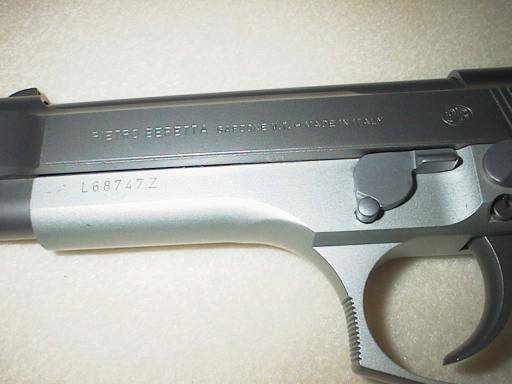
One thing I will say against them though is that I think the .40 S&W version, the Beretta 96, is pretty dire. I’m not sure why but I’ve used two of them and they were both appallingly inaccurate. My working theory is that the rifling twist in the barrel is not fast enough, but I don’t know why. This was quite a long time ago and Beretta may have solved this problem by now.
Magazines for the 92FS come in two main flavours, 15 round capacity:
And also the rarer 20 round mags, that were originally intended for the burst-fire Beretta 93R:
This magazine design is undoubtedly among the most widely copied, almost every maker of a 9mm pistol with a double-stack magazine since 1975 has copied it to some extent. I think these magazines were what gave magazine maker Mec-Gar their start in business, although Beretta uses their own tooling nowadays. If you live in Australia or Canada and are forced to buy ten-round magazines, they come with heavily indented sides to restrict the capacity.
If you’re interested in collecting modern pistols, your collection really isn’t complete without some variant of the Beretta 92FS in it, so go out and buy one now! They are plentiful and reasonably inexpensive (several million have been made). Frankly collecting variants of this gun is a hobby all on its own, and there are many collectors who do concentrate on them. There are more pictures on the Beretta website.

